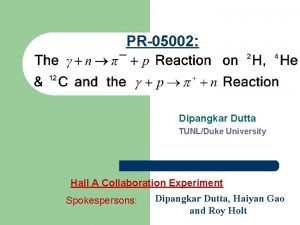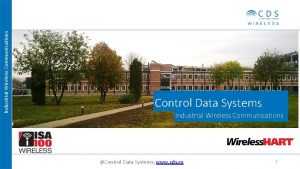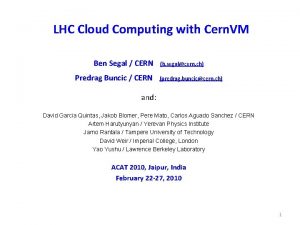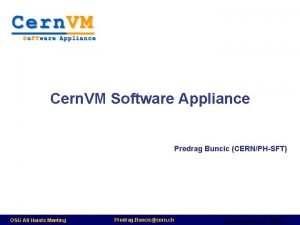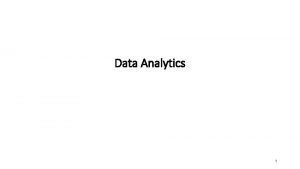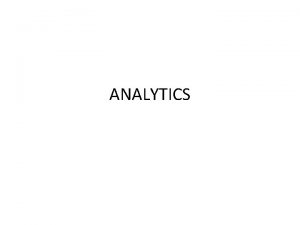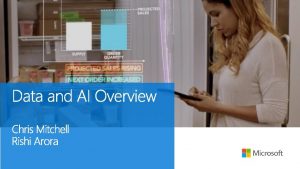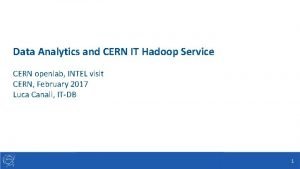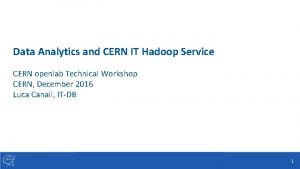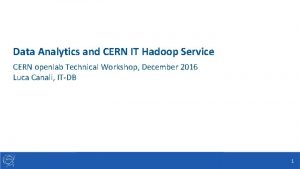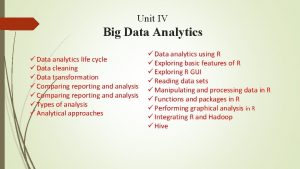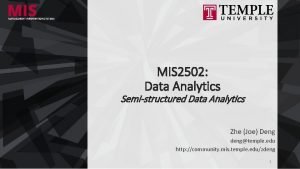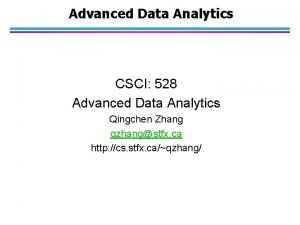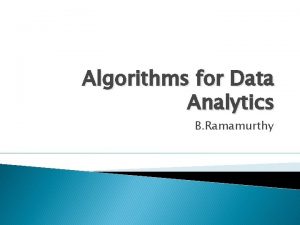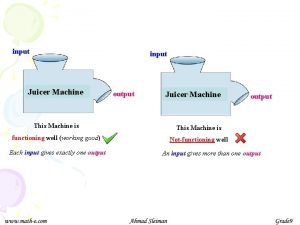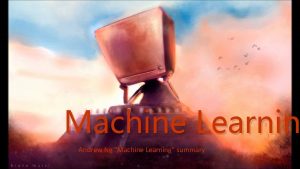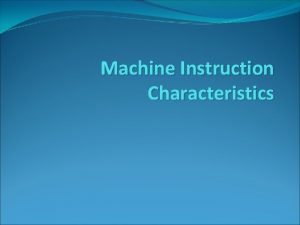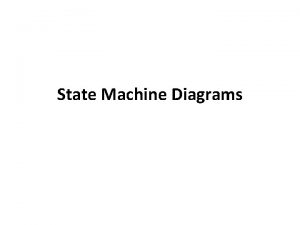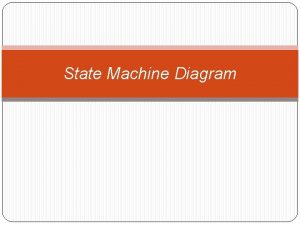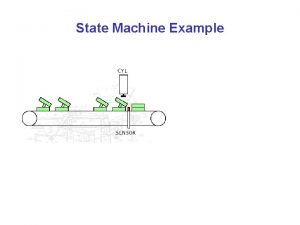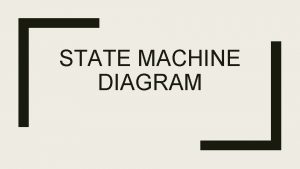Data Analytics for CERN Control Systems CERN Machine



























- Slides: 27

Data Analytics for CERN Control Systems CERN Machine Learning openlab workshop Geneva, April 2017 Filippo Tilaro Fernando Varela Rodriguez Manuel Gonzalez Berges Piotr Jan Seweryn 1

CERN: one of the world’s largest automation systems (Automation) Infrastructure Experiments Storing >100 TB of data per year 50 times more data than today in the next 10 years! › › several hundred automation components massive amount of operational data generated every day CERN openlab workshop › 24 active experiments › › over 1 PB/s of data generated by the detectors Up to 50 PB/Year of stored data (the accelerator currently in a service mode) 2

Our vision of the analytics framework Scalable and fault-tolerant !!! Data Analysis Framework Data Processing Modules >600 Win. CC OA systems MOON Supervision Analysis layer memory and configuration FFT Machine Learning Neural (Monitoring) Network (R) CEP Expert (Java) DIM/CMW ~500 control devices Patterns Process layer (Lab. View) (Watch. CAT) PLCs Data collection & feedback Fieldbus ~45 Millions IOs Field layer Sensors & Actuators CERN openlab workshop TN Visualisation OPC High Voltage Historical Data 6

CERN control system use-cases Based on real examples CERN openlab workshop

Use-cases classification › Online monitoring § Continuous service to analyse the system status and inform operators in case of fault detection › Fault diagnosis § “Forensics” analysis of system faults that have already happened in the past. In some cases root-cause analysis › Engineering design § Analysis of historical data to draw conclusions about system behaviours which could be helpful to improve / optimize the system under analysis CERN openlab workshop 5

Online monitoring • Oscillation analysis in cryogenics valves (CRYO, CV) • Online analysis of control alarms CERN openlab workshop

Oscillation analysis for cryogenics valves › Goal: detect whenever a signal is oscillating in any anomalous way. Impact on: § Control system stability § Increased communication load § Maintenance (use of actuators) § Safety § Performances (Physic time) CERN openlab workshop 7

Oscillation analysis flow Use of machine learning: › Threshold learning model › Dynamic learning › Associate the oscillation with system status conditions On-line analysis: › > 3000 sensors › Continuous analysis CERN openlab workshop 8

Oscillation detection Ex#1 CERN openlab workshop 9

Oscillation detection Ex#2 CERN openlab workshop 10

Oscillation detection on Spark Client #1 Client #2 Client #3 VM VM Driver HDFS CERN Cloudera Cluster provided by IT-DB Group

Oscillation detection & Win. CC OA › Status: § Working prototype § Testing › Next steps: § § § Extension for custom analysis types Compatibility with Win. CC OA 3. 15 User Documentation CERN openlab workshop 12

Online analysis of control alarms • Alarms analysis to detect anomalies or abnormal behaviors for thousands of devices • Events sequence mining • to understand the alarms’ dependencies • for short term forecast • Threshold learning algorithm and outliers detection techniques • Based on alarms’ distribution • Parallelization using the CERN Open. Stack cluster • Graphical visualization of the anomalies/outliers MOON: control system infrastructure monitoring Web Reporting Data Processing Anomaly detection CERN cloud computing CERN openlab workshop 13

Anomaly detection of control process variables based on custom indexes • Overview of the system through a list of indicators: • • • Analysis at different granularity: device, tag, level # / Average(#) of Alarms per Time Window Integration System Under Alarm Probability of Finding Alarm Frequency / Average of Frequency Instability Relative Strength CERN cloud Regularity computing • Identify significant changes in the data • Trending analysis and forecast (on-going) ETL CERN openlab workshop 14

Fault diagnosis (off-line) • Root cause analysis for control alarms avalanches (GAS system) • Anomaly detection by sensors data mining CERN openlab workshop

An example: Gas control system @CERN § § 9 Apps 6 Apps 7 Apps § § 6 Apps § CERN openlab workshop 28 gas systems deployed around LHC 4 Data Server, 51 PLCs (29 for process control, 22 for flow-cells handling) Essential for particle detection Reliability and stability are critical Any variation in the gas composition can affect the accuracy of the acquired data ~18 000 physical sensors / actuators 16

Alarm flooding problem Domino effect Fault in the distribution system › Alarms flooding Diagnosing a fault is complex: it may take weeks! § § § Alarms flooding: a single fault can generate up to a thousand of events Number of different sequences: ~6 x 10297 from: n!/(n-k)! , n=max seq. length, k=n/10 A single fault can stop the whole control process The 1 st alarm is not necessarily the most relevant for the diagnosis Alarm generation depends on the system status CERN openlab workshop 17

Events stream analysis Learn Diagnose Data Analyze Event lists generated by the same fault Identify and detect fault / abnormal pattern for Diagnosis and Prognostics based on domain knowledge Provide experts with Root-cause and Gap Analysis using Rules and Patterns Mining Pattern АА B A A B Forecasts, Trends and Early-Warnings to increase Operating Hours Alarm X T C D F A A E D N D B K D F A A B K D CERN openlab workshop 18

Anomaly detection by sensors data mining • Goal: Detect abnormal or unforeseen system behaviours • Possible issues: • • • Sensors faults/glitches Hardware failures/degradations False measurements Wrong tuning/structure … • Sensors mining to learning: • Logical relations • Physical relations • Challenges: • • • Normal/anomalous boundaries are not precise Different application domains/systems Mostly unsupervised training Dynamic system => dynamic model Different types of anomaly Noise and duration of an anomaly CERN openlab workshop 19

Machine learning algorithms for anomaly detection in Cryo • • Building a model based on historical data 3 different algorithms • Correlation index and KNN-graph • K-Mean clustering and probability model • Statistics expert-based model LHC Logging Service Sensors data extraction Learning phase sj dij si sj sj Anomaly detection • • • Use the previous model to detect anomalies On-line analysis over a time window of 1 day Continuous analysis against thousands of sensors CERN openlab workshop 20

Engineering design • PID supervision (CRYO, CV) • Recommendation system for Win. CC OA users (PSEN) CERN openlab workshop

Evaluation of PID supervision › › › In collaboration with the University of Valladolid Based on: “Performance monitoring of industrial controllers based on the predictability of controller behaviour”, R. Ghraizi, E. Martinez, C. de Prada PID performance has an impact on: § § § Issues: § § § w SP Process security Quality of physics Maintenance (stress on the equipment) Many sources of faults/malfunctions System status dependency External disturbances/factors Bad tuning Wrong controller type/structure v Slow degradation Controller u MV Process y CV CERN openlab workshop 22

PID supervision Ex#1 › PID anomaly detection: § Learning each PID model from the historical data § Extraction of similar PID models § Comparison of PID behaviours: on the single PID level similar PID › Bad Efficiency of control process: § Comparison of PID performances § Time/actions taken/energy consumed to reach steady points § Stability of the controlled variable Good CERN openlab workshop 23

PID supervision Ex#2 Bad Good CERN openlab workshop 24

Recommendation system for Win. CC OA users Users’ usage gap analysis Normalized distribution of panels usage Concentrate the effort to optimize the most used panels Users’ actions extraction Users’ frequent sequences Recommendation of panels based on the specific users’ sequences Jaccard Sequences Similarity Recommendation of panels based on users’ sequences similarities CERN openlab workshop 25

Data Analytics Benefits › › › Increased System Reliability § Minimized forced outages Complete data analysis § Reduced service effort: weeks hours 24/7 Expert Knowledge Availability § One central knowledge base Operation support › › › Big data visualization Forecast system status and take proper actions in time Prevent possible faults and system downtime Diagnosis support › › Identify root causes More accurate analysis Accelerate analysis From weeks to hours Identify hidden patterns CERN openlab workshop Engineering support › › › Evaluate and improve operational performance Increase reliability and efficiency by design Lead control system decisions 26

Use-cases: a partial list › › › Online monitoring § Control System Health § Electrical power quality of service § Looking for heat in superconducting magnets § Oscillation in cryogenics valves § Discharge of superconducting magnets heaters § Trending and forecast of the control process behavior § Electron cloud heat load estimation Faults diagnosis § Anomalies in the process regulation § PLC anomalies § Data loss detection § Root-cause analysis for complex Win. CC OA installations § Analysis of sensors functioning and data quality § Analysis of OPC-CAN middleware § Analysis of electrical power cuts § Cryogenic system breakdowns Engineering design § Electrical consumption forecast § Efficiency of electric network § Predictive maintenance of control systems elements § Predictive maintenance for control disks storage § Vibration analysis § Efficiency of control process § … CERN openlab workshop 27
 Earth observing system data analytics
Earth observing system data analytics Earth observing systems data analytics
Earth observing systems data analytics Teramond
Teramond Trimble accugrade
Trimble accugrade Control data systems inc
Control data systems inc Hdlc adalah
Hdlc adalah Cern virtual machine
Cern virtual machine Cern virtual machine
Cern virtual machine Kontinuitetshantering
Kontinuitetshantering Typiska novell drag
Typiska novell drag Nationell inriktning för artificiell intelligens
Nationell inriktning för artificiell intelligens Returpilarna
Returpilarna Varför kallas perioden 1918-1939 för mellankrigstiden?
Varför kallas perioden 1918-1939 för mellankrigstiden? En lathund för arbete med kontinuitetshantering
En lathund för arbete med kontinuitetshantering Kassaregister ideell förening
Kassaregister ideell förening Tidbok för yrkesförare
Tidbok för yrkesförare A gastrica
A gastrica Förklara densitet för barn
Förklara densitet för barn Datorkunskap för nybörjare
Datorkunskap för nybörjare Stig kerman
Stig kerman Debatt mall
Debatt mall Magnetsjukhus
Magnetsjukhus Nyckelkompetenser för livslångt lärande
Nyckelkompetenser för livslångt lärande Påbyggnader för flakfordon
Påbyggnader för flakfordon Formel för lufttryck
Formel för lufttryck Svenskt ramverk för digital samverkan
Svenskt ramverk för digital samverkan Bo bergman jag fryser om dina händer
Bo bergman jag fryser om dina händer Presentera för publik crossboss
Presentera för publik crossboss


